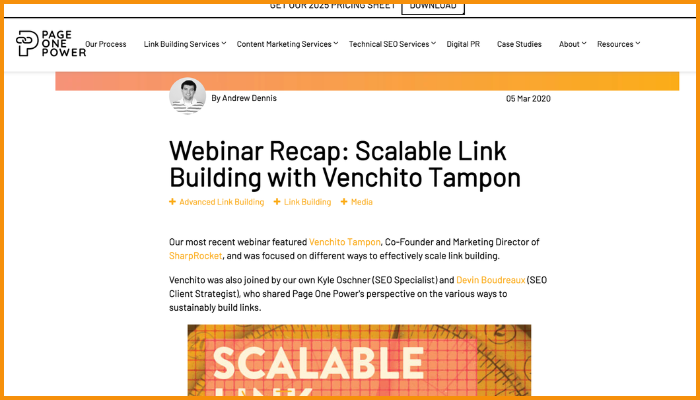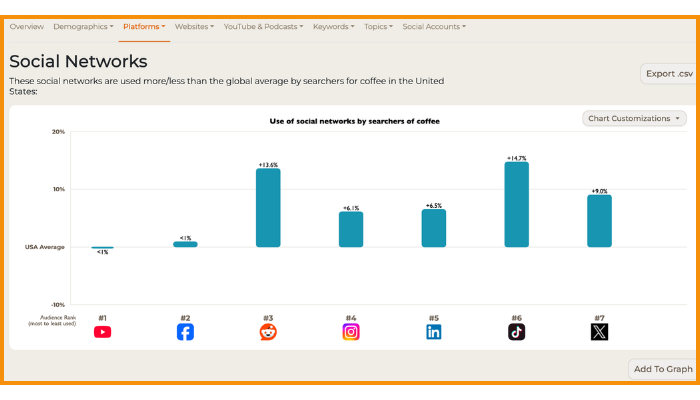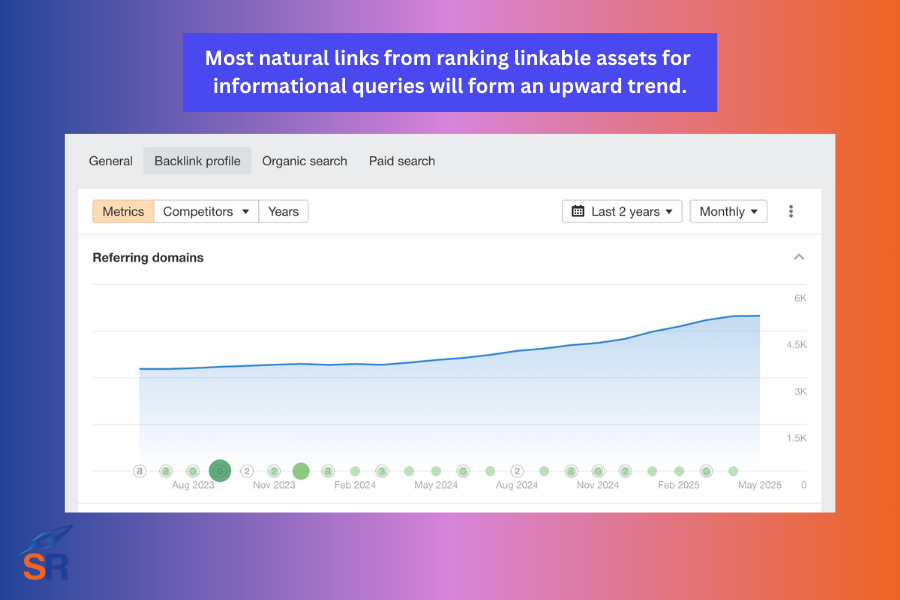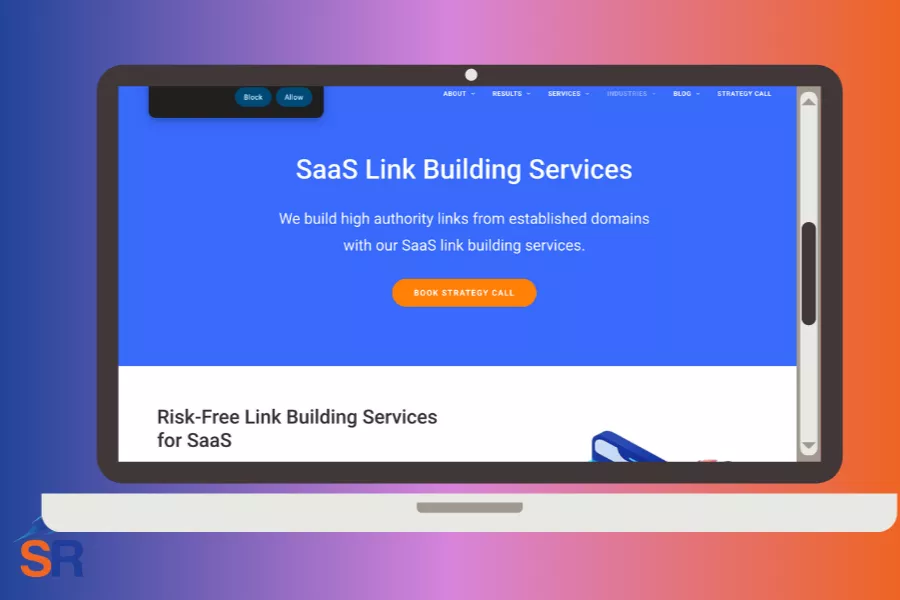Backlinks remain one of the strongest signals that influence rankings. Even with all the changes in how users search (AI overviews, featured snippets, and LLMs like ChatGPT and Perplexity pulling answers directly from the top results in organic search listings), link building would remain a vital component of SEO.
Given that AI tools reference trusted sources, if your site, product, or content is cited often, it has a better chance of showing up as a referenced authority in search results and AI summaries and answers.
This shift makes link building not just an SEO tactic but has become part of your brand visibility strategy. It helps in the overall packaging of your brand on search, helping you strengthen the following:
- Discovery – making sure people find you from organic search listings, LLMs, and curated bottom-of-the-funnel content of other publications.
- Reputation – proving you’re a trusted source of information in your space.
- Conversions – sending traffic from diverse sources (referral traffic from other curated listings, ChatGPT, forum discussions, etc..).
- Brand positioning is at the top of your mind and the top of the search, as your target audience may find you in different places.
Link building is no longer a game of pushing rankings; it is now a game of maximum visibility, where more visibility can help influence the purchasing decisions of your target customers.
In this guide, I’ll discuss advanced link-building strategies that go beyond the basics and help you stay visible in an SEO landscape shaped by AI and brand authority.
Contents
Toggle1. Citation-Driven Links
Search engines and AI tools like ChatGPT depend on sources they trust. These tools don’t just look at who has a link. They look at who gets mentioned often across the web. This is where citation-driven link building becomes a powerful strategy.
What Are Citation-Driven Links?
Citation-driven links are backlinks from sites that mention your brand, services, or content in a trusted context. They are references found in curated lists, industry roundups, tool directories, and comparison content pieces (pages where decision-makers actually go to evaluate options).
AI Overviews, ChatGPT responses, and search engines use these mentions to assess credibility. If your website is included in well-known directories, comparison articles, and tool roundups, it tells algorithms your brand is relevant, trusted, and deserves its proper visibility.
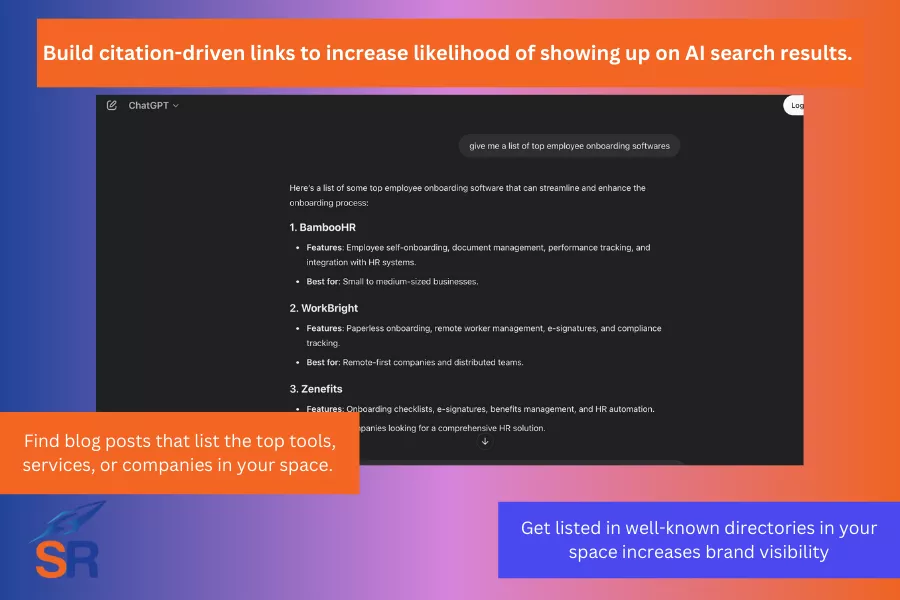
How to Earn Citation-Driven Links?
Focus on getting featured in content where people are already looking for solutions. Here are actionable tips to help you earn citation-driven links:
Pitch for Industry Roundups
Find blog posts that list the top tools, services, or companies in your space. These roundup pages already exist and are visited by people ready to decide. Your link building goal is to get your brand featured.
For instance, if you’re promoting a project management tool (a highly saturated space), you can search for roundup articles like “Top Project Management Tool for Remote Teams” and “Best Trello Alternatives For Agile Teams.”
These similar posts attract high-intent readers and could influence LLMs (with the listicle posts that rank) to feature your product as one of the go-to solutions.
Use an angle that makes your product stand out instead of a random, desperate email outreach pitch. Instead of just saying, “Please include this tool”, show why your tool deserves a spot. You can say:
“We’d love to be considered for your list of top tools for remote teams. Our platform has built-in video collaboration and task tracking that eliminates the need for separate Zoom calls—something many remote teams actively seek.”
Add credibility with results, use cases, or testimonials. If possible, share a client success story or specific outcome.
“One of our users reduced weekly meeting time by 40% after switching to our tool. We believe your audience of remote team managers would find value in that.”
Offer something in return to increase your chances of link placements in those citation-driven pages. Mention that you’ll share the post with your accounts once you’re included to get more reach, or suggest adding a helpful quote or stat to make the post more comprehensive.
Roundups exist to help readers compare, so highlight what makes your offer different or valuable from their point of view.
Submit to Trusted Directories
Getting listed in well-known directories in your space increases brand visibility and the likelihood of being cited in AI answers.
Circling back to our example earlier, if you’re offering a project management app, you can target trusted directories to be listed, like:
- Product Hunt
- G2
- Capterra
- GetApp
- Software Advice
These platforms are often the first stop for people searching for tool reviews or comparisons (in fact, many software users go directly to those tool comparison sites to find credible tools). Those trusted directories often appear in AI summaries, listicles, and Google’s top results for “Best X for [use/purpose].”
To maximize your product listing, write a clear, benefit-focused profile. Focus on your product’s purpose and how it helps. Use keywords naturally so AI and search engines understand what you offer.
“A project management app built for remote marketing teams. Features include time tracking, real-time comments, and integrated campaign dashboards.”
Ask your users to leave honest feedback. Reviews will help you stand out and influence decision-makers.
You may also add visuals and product walk-throughs. Include screenshots or videos that explain your key features, improving your engagement and increasing your chances of being cited by bloggers or roundup writers.
2. Strategic Content Placements (Link Insertions)
Many people are familiar with the term “link insertion” or “niche edits” when it comes to strategic content placements. These are about earning links from existing content that already has value.
Instead of writing a full guest post, you insert a backlink into a relevant paragraph of a published blog or article that is contextually worthy for the publisher to include your short-form content.
Search engines trust pages that are aged, indexed, and performing well in page rankings (they rank for keywords, able to get search traffic).
Adding your link to one of these strengthens your destination page by association, so you’re not building from a newly indexed page or an article with a proven SEO value.
Start with the right blog posts. Target high-quality blog content, not just any random blog, to get the best results. What you should be looking for:
- Blog posts with organic search traffic
- Topic that fit naturally with your content
- Sites that are open to updating older posts
Prospect for industry-relevant blogs and publications. Then, use the advanced search operator (site:domain.com “topic”) to find indexed articles of the target website. This helps you locate specific pages where your content could fit.
Then, you can use tools like Ahrefs or SEMRush to check if the domain gets traffic before diving into specific articles. You can filter for blog posts with organic traffic of 50 or 100>/month and page content with relevant topics or keywords.
When pitching to these bloggers, make sure that your destination link makes sense for them to include in their existing content. If you’re linking to a content marketing tool, don’t force it into a post about web hosting (it would only dilute your website’s off-page SEO relevance).
Instead, find blog posts discussing similar services, related informational content, or complementary tools. The link should enhance the page’s content, not distract readers.
Many publishers would appreciate getting pitches to improve more of their old content, particularly with the intent to add or regain the search traffic that may have been lost.
When pitching to publishers, you can offer value, such as improving the article with fresh data or adding a unique perspective on the article where it makes sense to link to your destination page for additional reference or resources.
3. Digital PR
Digital PR has become a core strategy for many SEO and digital marketing strategies. It helps clients earn brand mentions and links by sharing stories worth covering.
The brand strategy works well, given that journalists, influencers, and content creators always look for credible sources, fresh insights, and original data to cite in their articles.
Digital PR links are editorial and natural and often come from media sites or top-tier blogs, making them robust for SEO and brand visibility.

Expert Commentaries
One powerful way to do digital PR is by offering expert quotes to journalists that help share the story they’re writing. As reporters by profession, they can’t simply quote their own opinions. They need external inputs and credible insights to support their content, making their written content more trustworthy.
The best quotes are:
- Concise (answers what they look for: tip, insight, or trend).
- Authority-driven (use data, experience, or unique takes)
- Actionable (something readers can think about or apply)
There are a couple of platforms where you can find quote requests and media opportunities, including:
- Journo (new quote request platform by Search Intelligence UK)
- Qwoted
- Featured.com
Another way to leverage expert commentaries is to send direct pitches to writers or editors. If you have an interesting list of tips relevant to your industry by first search for what topics they religiously write for (based on the past year’s content), you can nudge them with your own sets of tips that will benefit their readers.
Make sure you track these opportunities using Ahrefs or Google Alerts. Thank the writer and stay on their radar for future stories.
Reactive PR
Reactive PR is all about speed and relevance.
You earn backlinks by quickly responding to trending topics, breaking news, or cultural moments with expert insights.
Unlike general digital PR, where you wait for coverage, with reactive PR, you insert your brand into the conversation while it’s still hot. So, the faster you react (in digital PR terms), the higher the chance your quote gets featured and your website gets cited.
It works because journalists and content creators move fast. When a story breaks, or a topic goes viral, they need expert input immediately. If you’re one of the first to offer a relevant comment, tip, or angle, you become the source they quote.
Start reactive PR by monitoring the news. You can use platforms like:
- Google News – Track industry keywords and breaking headlines
- Twitter/X Trending Topics – See what’s being discussed now
- Subreddits – Join niche communities in your space
- BuzzSumo / Exploding Topics – Catch early content trends before they peak
You can choose one or a combination of many to get more trending news as fast as possible.
Create a reactive content calendar to harness the power of trending news. Map out important days and events such as:
- Upcoming Holidays
- Industry-specific awareness weeks
- Annual news cycles
- Recurring events (like product launches, sports finals, seasonal changes)
Instead of passively waiting for links, you build a system that maximizes reactive PR and has it ready. This way, you can respond within hours, not days.
Data-driven Campaigns
This is one of the most reliable ways to earn press coverage using digital PR campaigns. Unlike reactive PR, where you wait for breaking news to take advantage of, data-driven PR involves publishing original data that supports a specific insight.
For the UK, US, and AU countries, journalists and bloggers love using fresh stats to strengthen their upcoming articles, and when they do, they credit you with the backlink (most to your homepage).
Here are a couple of ways to generate valuable data, even with a small team:
- Quick internal surveys: Send a short survey to your audience, email list, or LinkedIn connections (e.g., see State of Link Building Report or SEO Agency Survey).
- Customer usage stats show how users interact with your product or service. Your platform’s insights are unique, making them difficult to replicate.
- Market research: Use tools like Statista, Office for National Statistics (UK), Google Trends, or industry reports to pull data and then reframe it (or combine it with your other sets of data) to produce high-utility data insights.
- Publish data re-analysis – pull government or academic datasets and analyze them with a fresh angle (e.g., “Using data from the Bureau of Labor Statistics, we ranked the top 10 fastest-growing freelance jobs in the U.S.”).
You can check our guide on digital PR tips for successful campaigns.
4. Integrated Linkable Assets to Landing Pages
In the past, the long-term SEO strategy has been built around creating linkable assets to attract passive links, coupled with using them as a value proposition in manual outreach to get an initial set of links. From there, attracting link opportunities from publishers at their writing stage becomes more visible as the linkable asset ranks for informational research terms.
The model worked for traffic and got dozens of high-quality backlinks, which you can leverage further by internally linking from the most-linked page to commercial pages. This way, the links will pass SEO value to landing pages, increasing their chances of ranking for their respective keywords.
Linkable asset creation was isolated. It created a unique backlink, but it didn’t connect directly to pages that drive leads or sales.
The best approach for developing an advanced link-building strategy in SEO is to integrate linkable assets into your landing pages and core site architecture. Surrounding it through topic clusters that push value toward your key pages helps in so many ways, such as:
- Backlinks earned by useful content also benefit pages where you convert visitors (no more internally linking from linkable page to commercial page).
- Authority flows naturally through your internal structure.
- Your highest-priority page (“commercial pages”) gets stronger rankings, not just blog pages.
By doing so, your most important pages—those that drive sign-ups, leads and
Instead of keeping your content separate, you:
- Build tools, visuals, or mini guides directly inside your landing pages.
- Create topic clusters where blog posts link to service or product pages.
- Turn high-converting pages into link-worthy resources, not just sales copy.
- Make purchases and start earning natural backlinks, too.
Don’t treat content and conversion as separate. Think like this, “how can I make this page so useful that someone would choose to link to it?”.
Here are actionable tips for integrating linkable assets into landing pages:
Create Landing Pages with value-added content.
Enhance product or service pages with:
- Interactive tools (e.g., calculators, ROI estimators, checklists)
- Quick-start guides or “how to use this” sections
- Case study snippets that give real-world proof
- Infographics that explain processes visually
For example, a time-tracking SaaS tool can include a “Time Theft Calculator” on its product page, giving publishers and media outlets a reason to link directly to that page when discussing workplace productivity.
Support Pages with Strong Internal Links.
Build help articles, tutorial pages, and onboarding content that support your primary services. These can act as natural backlink targets when people search for instructions, definitions, or “how it works’ content.
From there, you can use thematic internal linking to pass SEO value to the commercial page.
Thematic Hubs (Topic Clusters)
Group related content together. A “hub and spoke” structure helps improve topical authority and link equity flow.
- Hub = a central landing page
- Spokes = supporting blog posts or case studies that link back to the hub
Thematic hubs like this help landing pages rank for more competitive keywords and make them more discoverable to linkers looking for credible sources.
5. Build Topical Authority
A topical authority is about becoming the most trusted, complete, and referenced source on a specific subject.
When you build topical authority, your website doesn’t show up for one keyword (which most SEO still operate to this day), but you start ranking across dozens or even hundreds of related search terms. By becoming the go-to person or authoritative source in your space, others start linking to you because you’re seen as the expert.

Here’s how to build topical authority and attract backlinks your competitors can’t replicate:
Choose a specific, business-aligned topic.
Pick one area where your product or service is highly relevant and where your team has deep insight or real experience to provide loads of “informational gain” that hasn’t been brought to the table.
The level of specificity you get will make your content more valuable to a defined audience and more link-worthy in relevant articles and roundups.
Build out subtopics that cover the topic thoroughly.
To become authoritative, your site should answer everything someone might ask within the space (a battle of high-quality “content volume”).
When a journalist or publisher looks for expert-level information, your site will have it already written and easy to link to. The idea is that your competitors may have 1 to 2 posts on the topic, but you’ll have 15+ highly targeted pages that connect and support each other.
Structure it as a topic cluster.
I shared earlier about organizing your content into a hub-and-spoke model. Cross-links between pages so users and search engines can easily navigate your expertise. Potential linkers can quickly see the depth of your coverage, making it more likely they’ll link to you rather than a thin, one-off post from someone else.
Add unique value that others can’t copy.
This is the step that locks in your backlinks. Include content elements based on your own data, tools, experience, or perspective (as I’ve shared in the integrated linkable assets section).
These aren’t generic tips; they are assets only you can offer. So, even if your competitor writes a similar post, they won’t have your exact angle or insights, making your content the preferred link target.
6. Value-First Outreach
Most link-building outreach fails because it’s one-sided (most of the time). Value-first outreach flips that, offering something helpful first (“reciprocity effect”).
Website owners, bloggers, and journalists receive dozens of link requests weekly. To stand out, your email outreach needs to answer one question: “What’s in it for them?”
Value-first outreach earns links by earning trust first, and here are a couple of ways to test in your email outreach campaigns:
- Link swaps—if you manage content for multiple clients or partners, offer a relevant link in return, but no direct change. This method helps you get exposure and stay within the conservative way of doing link building by using indirect or triangular swaps (not one-to-one link exchanges).
- Improve their content with helpful additions—offer insight, data, or clarification to make their existing content more comprehensive. Do the work upfront to make it easy for them to say yes.
- Share or mention their content first (scale it for priority link targets). If you already like their work, mention it in your content before asking for a link, giving them exposure and SEO value upfront. Then, use that goodwill in your outreach.
Value-first outreach works best when you think like a collaborator, not a solicitor.
7. Get Links From Prospect Business Sites (Not Just Industry Blogs)
When building the right types of backlinks, most outreach efforts focus on the usual: industry blogs, roundup sites, and content-focused publications. There’s nothing wrong with that unless you’re getting from sites with no significant and relevant traffic. However, there’s a high-value group to target for links that, more often than not, are overlooked. These are business websites.
Business websites are seen as legitimate by both users and search engines, as they have real-world operations, band equity, existing links from vendors, partners, and local institutions, and minimal outbound link spam.
Getting links from these types of domains carries more weight in link value and is often more challenging for competitors to replicate.
For example, if you sell premium workout mats. Instead of pitching fitness blogs, reach out to:
- Gyms or fitness studios that have a “Recommended Equipment” page
- Athletic trainers who list gear they use with clients
- Franchised gym chains that feature supplier shoutouts on their blog
Another example is if you offer eco-friendly packaging, don’t just target green blogs. You can reach out to organic food companies that:
- Feature vendors or suppliers they work with
- Highlight sustainability partners in blog posts
- Have “Sustainability in Our Supply Chain” sections on their site
I can give you more examples, but the principles remain the same: find more business websites with existing resources or blog sections where you can get contextual backlinks to your site.
8. High Link Value with Strategic Content Distribution
Most content distributed on other websites (“guest posts“) is treated as one-off link drops. The contributor writes the content, publishes it, and the backlink goes live. Done.
However, if that’s where it ends, you’re missing the actual value of external content assets. To build high-value backlinks, you need to shift from simply placing content to distributing content that ranks and drives traffic for you and the publisher.
It’s a win-win scenario where both parties enjoy the benefits of high-utility content (the publisher gets more traffic while bringing this traffic to the one contributing the content). That’s where strategic content distribution comes in.
Strategic content distribution means creating external content pieces that are designed to rank and crafted to match gaps in your target publisher’s SEO strategy.
So, instead of just writing a random topic, you write:
- On a topic (or keyword) that’s highly relevant to your target customers
- That fits well the publisher’s niche
- That’s currently missing from their blog or resources section
- That attracts search traffic over time, and they aren’t tapping into it yet.
Instead of a mere guest post, you create content that significantly has an impact on your website, given that links:
- Sit on a page that ranks, not buried archive post
- The blog post continues getting traffic over time, sending indirect SEO and brand signals
- Content earns secondary links when others reference the post
- You’re seen as someone who improves the site, not just using it for plain reasons.
Here’s how to distribute content strategically:
Find the right publishers.
Look for websites that have decent domain authority (e.g. Ahrefs DR30+), regularly publish new content, rank for keywords related to your niche, and accept contributions or have a blog that could benefit from SEO support.
You can use tools like Ahrefs, or SEMRush to assess traffic and ranking potential.
Identify content and traffic gaps on their blog.
Before pitching, do a quick content gap analysis by asking what keywords and topics they are not ranking for and are missing entirely from their blog. Are there blog posts ranking on page 2 that you can help improve or refresh?
To spot thin content, you can use advanced search operators (site: domain[dot]com “topic) or tools like Clearscope or SurferSEO.
Choose topics with the potential to get traffic or with steady search volume.
Target long-tail keywords with lower keyword difficulty (KD), a monthly search volume of at least 100 to 1,000, and that have a clear connection to your niche or target audience.
These terms are easier to rank for and can help deliver long-term traffic to the publisher.
Pitch content that helps them, not just you.
Craft your pitch around how the article can benefit their readers and increase traffic potential.
A sample addition to your outreach pitch would be:
“I noticed your blog doesn’t currently cover [topic], which has consistent search volume and ties closely to your audience. I’d love to write a well-structured piece on that, including a few unique insights from our team.”
“I’ll optimize the post to rank for [keyword]—and link to your internal content where relevant, to strengthen your rankings.”
You’re positioning yourself as a content partner looking for a more long-term role in content distribution, not a self-serving contributor only asking for links.
Need link building? See our link building services and schedule your free strategy call.
Written By
Venchito Tampon
CEO and Co-Founder at SharpRocket, a link building agency. With a decade of experience, Venchito has a proven track record of leading hundreds of successful SEO (link builidng) campaigns across competitive industries like finance, B2B, legal, and SaaS. His expert advice as a link building expert has been featured in renowned publications such as Semrush, Ahrefs, Huffington Post and Forbes. He is also an international SEO spoken and has delivered talks in SEO Zraz, Asia Pacific Affiliate Summit in Singapore, and Search Marketing Summit in Sydney, Australia. Check out his other business - Hills & Valleys Cafe.
Reviewed By

Sef Gojo Cruz
COO at SharpRocket, overseeing end-to-end operations, from crafting link building strategies to leading high-performing teams. Previously led SEO initiatives at Workhouse, a digital agency in Australia, and Keymedia, a real estate media company based in New Zealand.
How our LINK BUILDING AGENCY in UK builds 250 links/mo consistently using Predictable Link Building Methodology™…
- Using a SIMPLE and PROVEN system
- Using a SCALABLE strategy
- No private blog networks
- No creepy outreach emails

